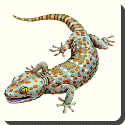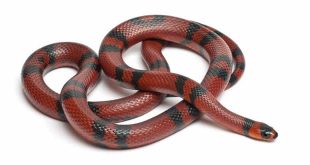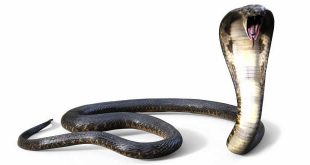 Gecko — Geckos are small to average sized lizards belonging to the family Gekkonidae which are found in warm climates throughout the world. Geckos are unique among lizards in their vocalizations, making chirping sounds in social interactions with other geckos. There are 1,196 different species of geckos. The name stems from the Malay word gekoq, imitative of its cry. Geckos are unusual in other respects as well. Most geckos have no eyelids and instead have a transparent membrane which they lick to clean. Many species will, in defense, expel a foul-smelling material and feces onto their aggressors. Many species have specialized toe pads that enable them to climb smooth vertical surfaces and even cross indoor ceilings with ease. These antics are well-known to people who live in warm regions of the world where several species of geckos make their home inside human habitations. These species (for example the house gecko) become part of the indoor menagerie and are seldom really discouraged because they feed on insect pests.
Gecko — Geckos are small to average sized lizards belonging to the family Gekkonidae which are found in warm climates throughout the world. Geckos are unique among lizards in their vocalizations, making chirping sounds in social interactions with other geckos. There are 1,196 different species of geckos. The name stems from the Malay word gekoq, imitative of its cry. Geckos are unusual in other respects as well. Most geckos have no eyelids and instead have a transparent membrane which they lick to clean. Many species will, in defense, expel a foul-smelling material and feces onto their aggressors. Many species have specialized toe pads that enable them to climb smooth vertical surfaces and even cross indoor ceilings with ease. These antics are well-known to people who live in warm regions of the world where several species of geckos make their home inside human habitations. These species (for example the house gecko) become part of the indoor menagerie and are seldom really discouraged because they feed on insect pests.
Geckos come in various colors and patterns. Some are subtly patterned, and somewhat rubbery looking, while others can be brightly colored . Some species can change color to blend in with their surroundings or with temperature differences. Some species are parthenogenic, the females capable of reproducing without copulating with a male. This improves the gecko’s ability to spread to new islands.
The toes of the gecko have attracted a lot of attention, as they adhere to a wide variety of surfaces, without the use of liquids or surface tension. Recent studies of the spatula tipped setae on gecko footpads demonstrate that the attractive forces that hold geckos to surfaces are van der Waals interactions between the finely divided setae (almost 500,000 setae on each foot, and each of these tipped with between 100 and 1,000 spatulae) and the surfaces themselves. The length of each seta is twice the diameter of a human hair, i.e 100 millionth of meter and each spatulae is 200 billionth of meter long just below wavelength of visible light. These kinds of interactions involve no fluids; in theory, a boot made of synthetic setae would adhere as easily to the surface of the International Space Station as it would to a living room wall, although adhesion varies with humidity and is dramatically reduced under water, suggesting a contribution from capillarity. The setae on the feet of geckos are also self cleaning and will usually remove any clogging dirt within a few steps.
 Kids Portal For Parents India Kids Network
Kids Portal For Parents India Kids Network


